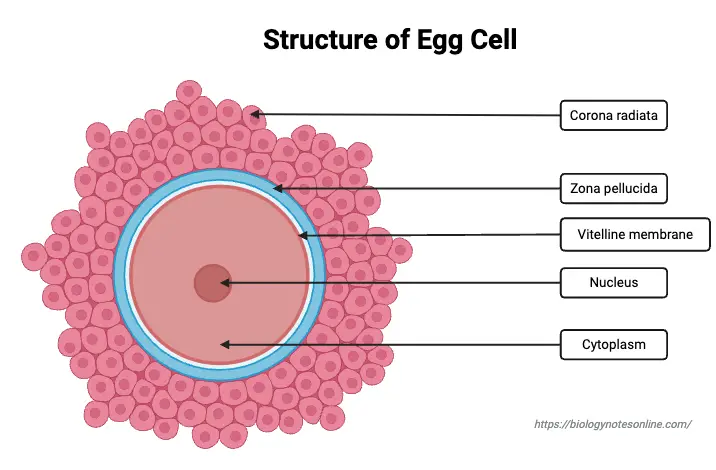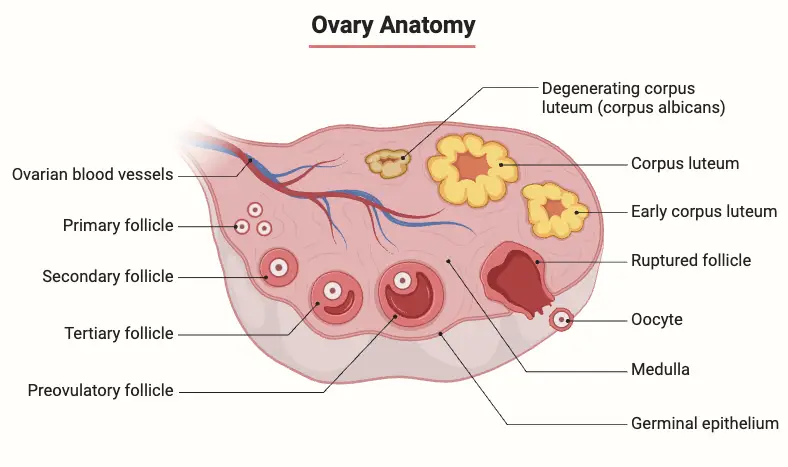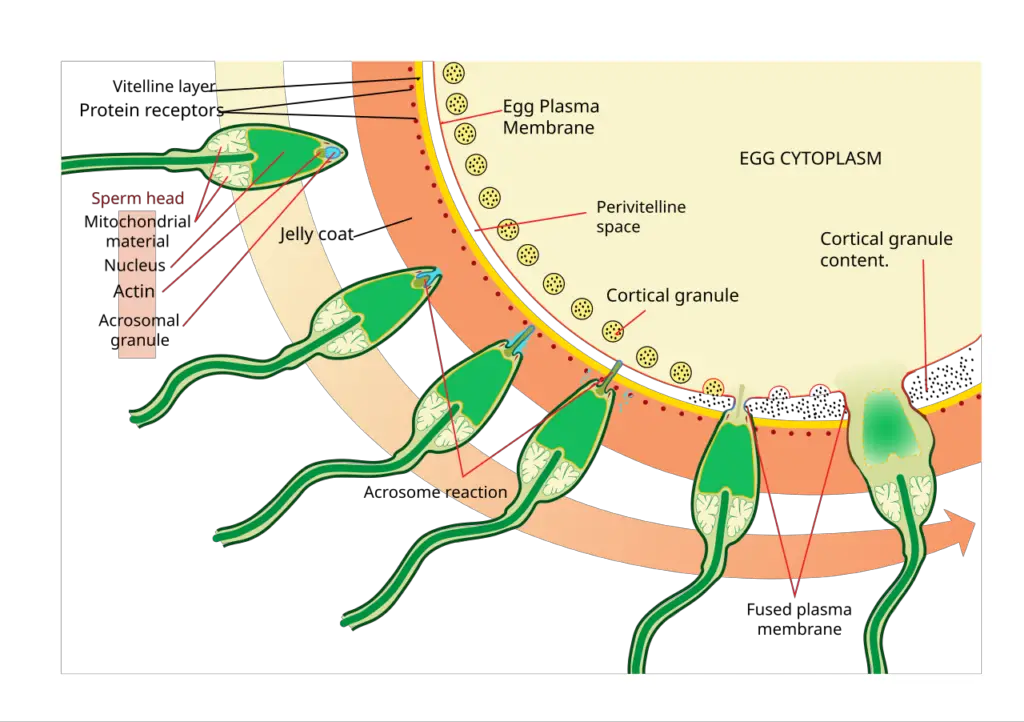What is Egg Cell?
- The egg cell, scientifically termed the ovum, serves as the female gamete in sexual reproduction for many anisogamous organisms—those that exhibit distinct sizes between male and female gametes. Unlike the motile sperm cell, the ovum is a non-motile reproductive cell that plays a crucial role in the fertilization process and subsequent development of a new organism.
- Egg cells originate from a specialized process known as oogenesis, which takes place within the ovaries, the primary reproductive organs in females. Throughout a female’s reproductive lifespan, a finite number of egg cells are produced. These cells may remain dormant for extended periods before maturation, whereas others may not fully develop. The maturation process is vital as it prepares the ovum for potential fertilization.
- A defining characteristic of the egg cell is its haploid nature, which means it contains half the number of chromosomes found in somatic cells. Specifically, this genetic composition is critical as it allows for the formation of a diploid zygote upon fusion with a sperm cell during fertilization. This union of genetic materials from both the sperm and egg establishes the genetic framework for the future offspring, influencing traits and characteristics.
- During fertilization, the egg cell merges with the sperm, resulting in the formation of the zygote. This zygote, a diploid cell, undergoes rapid cellular division and differentiation, ultimately leading to the development of a new organism. The historical perspective on reproduction, notably articulated by William Harvey in the 17th century with the doctrine ex ovo omne vivum—asserting that all living animals arise from eggs—reflects the significance of the egg in the reproductive cycle. Moreover, Karl Ernst von Baer’s identification of the mammalian ovum in 1827 expanded the understanding of reproduction beyond non-mammalian species.
- In viviparous animals, the fertilized ovum develops within the female body, specifically in the uterus, where it undergoes crucial stages of embryonic development. This internal gestation contrasts with oviparous species, where eggs are laid externally. In all cases, the gonads—testes in males and ovaries in females—play a central role in gamete production, ensuring the continuity of species through sexual reproduction.
Definition of Egg Cell
An egg cell, or ovum, is the female reproductive cell in sexually reproducing organisms. It is a haploid cell produced in the ovaries through oogenesis and is essential for fertilization, as it combines with a sperm cell to form a diploid zygote, which can develop into a new organism. The egg cell contains the female’s genetic material and plays a critical role in genetic inheritance and development.
Structure of Egg Cell
The egg cell, or ovum, is a large, spherical reproductive cell essential for sexual reproduction in many organisms. Its structure is meticulously designed to facilitate fertilization and support the early stages of embryonic development. Below is a detailed overview of its components and functions.
- Overall Size and Shape: The egg cell typically measures around 120 µm in diameter and is non-motile. The size can vary significantly across different species, ranging from 10 millimeters to several centimeters.
- Layers Surrounding the Egg Cell:
- Corona Radiata: This outermost layer consists of follicular cells that provide nourishment and protection to the ovum. It plays a critical role in the initial stages of fertilization.
- Zona Pellucida: Beneath the corona radiata lies the zona pellucida, a thick, transparent, non-cellular layer composed of glycoproteins. This layer not only supports the egg structurally but also facilitates sperm-egg interaction, crucial during fertilization.
- Vitelline Membrane: The innermost layer is the vitelline membrane, a thin, transparent barrier secreted by the egg cell itself. This membrane adds an extra layer of protection for the egg.
- Cytoplasmic Composition: The cytoplasm of the egg cell is divided into two distinct regions:
- Exoplasm (Egg Cortex): This outer region contains cytoskeletal structures such as microtubules and microfilaments, essential for maintaining the cell’s shape and facilitating intracellular transport. Additionally, it houses cortical granules, which play a vital role in the activation of the egg upon sperm entry, modifying the egg coat to prevent polyspermy (fertilization by multiple sperm).
- Endoplasm (Ooplasm): The inner part, known as the ooplasm, contains various cell organelles, tRNAs, histones, enzymes, and essential nutrients. This region is rich in yolk reserves, providing proteins, lipids, and other nutrients necessary for the early development of the embryo.
- Nuclear Structure: The nucleus of the ovum, referred to as the germinal vesicle, is centrally located and houses the genetic material in the form of DNA. This genetic material is crucial for embryo development. The germinal vesicle is accompanied by the germinal disc, which is significant during fertilization.
- Polarity: The egg cell exhibits polarity, with the side containing the nucleus and polar body identified as the animal pole, while the opposite side is known as the vegetal pole.
- Perivitelline Space: The space between the zona pellucida and the vitelline membrane is termed the perivitelline space. This narrow area plays a role in the fertilization process.
- Fertilization Process: For fertilization to occur, the sperm must penetrate the outer corona radiata. This is facilitated by the enzyme hyaluronidase found in the sperm’s acrosome, which disperses the corona radiata and allows contact between the sperm and the oocyte’s core.

Types of Egg Cell
Egg cells can be classified based on the amount and distribution of yolk within them.
Based on the Amount of Yolk
- Alecithal Eggs: These eggs contain little to no yolk. They are typically found in mammals, including humans and eutherian animals. The developing embryo receives nourishment directly from the mother’s placenta rather than from yolk reserves.
- Microlecithal Eggs: Also known as oligolecithal eggs, these contain a small amount of yolk. This type is common in marine organisms, such as sea urchins and Branchiostoma. The modest yolk supply supports initial developmental stages before the embryo gains further nourishment.
- Mesolecithal Eggs: These eggs have a moderate amount of yolk, which is usually concentrated near the vegetal pole. This category includes eggs from amphibians, such as frogs and toads, where the yolk distribution assists in development post-fertilization.
- Macrolecithal or Polylecithal Eggs: Characterized by a large amount of yolk, these eggs are found in species such as sharks, bony fishes, reptiles, birds, and certain insects. The significant yolk supply is essential for sustaining the embryo during the early stages of development.
Based on the Distribution of Yolk
- Isolecithal Eggs: These eggs have yolk that is uniformly distributed throughout the cytoplasm. This type is typical of alecithal and microlecithal eggs, where the even distribution aids in the overall development of the embryo.
- Telolecithal Eggs: In these eggs, most of the yolk is concentrated near the vegetal pole, with the cytoplasm and nucleus positioned at the animal pole. This distribution is seen in mesolecithal and macrolecithal eggs. For instance, in chicken eggs, the substantial yolk occupies the majority of the ovum, while the cytoplasm and nucleus are localized at the animal pole, a scenario referred to as highly telolecithal.
- Centrolecithal Eggs: These eggs feature yolk that is centrally located within the cell, surrounded by a thin layer of cytoplasm. Centrolecithal eggs are observed in some insect species, where this arrangement supports their developmental needs.

Common Disorders Associated with Egg Cells
- Polycystic Ovary Syndrome (PCOS): This is a prevalent hormonal disorder affecting women of reproductive age. PCOS is characterized by irregular menstrual cycles, elevated androgen levels, excess body hair, and the presence of follicles on the ovaries that do not mature properly. These factors contribute to fertility issues due to irregular ovulation. While the exact cause of PCOS remains unclear, a family history and type 2 diabetes can increase the risk. Although there is no definitive cure for PCOS, symptoms can be managed through lifestyle changes and medications.
- Endometriosis: In this condition, tissue similar to the uterine lining grows outside the uterus, often leading to significant pain and fertility challenges. Endometrial tissue can form cysts on the ovaries, hindering the release of eggs. It commonly affects the ovaries, pelvic ligaments, and other organs such as the intestines and bladder. While endometriosis is a chronic condition without a cure, various treatment options, including pain medications, hormonal therapies, and surgical interventions to remove endometrial tissue, can provide relief.
- Primary Ovarian Insufficiency (POI): Also known as premature ovarian failure, POI occurs when the ovaries cease functioning earlier than expected, resulting in low estrogen levels and a decrease in both the number and quality of eggs. This condition often leads to infertility and can affect approximately 1% of women aged 15 to 44, with higher prevalence in those over 30. Causes of POI include autoimmune disorders, cancer treatments, genetic disorders such as Turner syndrome, and exposure to environmental toxins. Symptoms may vary but typically include irregular or absent menstrual periods, difficulties in conception, and menopausal-like symptoms. Management of POI focuses on alleviating symptoms and reducing associated risks, with treatments like IVF and hormone therapy available to enhance quality of life.
- Ovarian Cysts: These fluid-filled sacs can develop in the ovaries and are typically benign and functional. Most ovarian cysts resolve on their own without the need for surgical intervention. However, larger cysts can cause complications, including pelvic pain, rupture, excessive bleeding, and ovarian torsion, which requires immediate medical attention. It is crucial to monitor and, if necessary, surgically remove large cysts to mitigate these risks.
- Ovarian Cancer: This malignancy arises from abnormal cell growth within the ovaries, which are responsible for egg production during reproductive years. Symptoms of ovarian cancer may include pelvic pain, appetite changes, abnormal bleeding, and bowel irregularities. If left untreated, ovarian cancer can metastasize to other organs. The staging of the cancer assists in determining the appropriate treatment strategy, which may include surgery, chemotherapy, targeted therapies, hormone therapy, and, less frequently, radiation therapy. Ovarian cancer can adversely affect ovary function, leading to disruptions in egg production and maturation.
- Diminished Ovarian Reserve (DOR): This condition involves a decrease in the quantity or quality of eggs available in the ovaries, which can lead to challenges in conception due to fewer eggs available for ovulation. Individuals with DOR may not exhibit obvious symptoms other than difficulty conceiving, though some may experience shorter menstrual cycles. Factors contributing to DOR include aging, genetic predispositions, medical treatments such as chemotherapy, or autoimmune conditions. Treatment options may involve egg freezing for later use, natural conception efforts, or in vitro fertilization (IVF) utilizing either the individual’s or donor eggs. Lifestyle modifications, including weight management and avoiding smoking, can also promote egg health.

Key Functions of Egg Cells
- Fertilization: The primary function of egg cells is to fuse with sperm cells during fertilization. This union forms a zygote, which carries genetic material from both parents and eventually matures into a new organism. The egg cell contributes half of the required genetic information, thus establishing the foundation for the offspring.
- Nutrient Provision: Egg cells are rich in cytoplasmic components, notably yolk, which serves as a vital nutrient source for the developing embryo. The yolk contains essential proteins, lipids, and other nutrients that support the early stages of development before the embryo can establish its own nutritional sources.
- Chemical Signaling: Egg cells release specific chemical signals and molecules that attract sperm cells. These substances facilitate the sperm’s entry into the egg, thereby enhancing the likelihood of successful fertilization.
- Activation of Development: Upon fertilization, the egg undergoes significant changes in its membrane potential and biochemical processes. These changes activate the zygote, initiating cell division and subsequent embryonic development. This activation is crucial for the successful transition from a single-celled zygote to a multicellular organism.
- Prevention of Polyspermy: Egg cells possess mechanisms to prevent multiple sperm cells from fertilizing the same egg. This ensures that only one sperm can successfully enter the egg, thereby maintaining the correct genetic balance. The egg’s cortical granules play a significant role in modifying the egg’s outer layer upon sperm entry, creating a barrier against further sperm.
- Alberts B, Johnson A, Lewis J, et al. Molecular Biology of the Cell. 4th edition. New York: Garland Science; 2002. Eggs. Available from: https://www.ncbi.nlm.nih.gov/books/NBK26842/
- Human Egg Cells. (2021, March 6). https://bio.libretexts.org/@go/page/6809
- Sathananthan AH. Ultrastructure of the human egg. Hum Cell. 1997 Mar;10(1):21-38. PMID: 9234062.
- Springate, Leah & Frasier, Timothy. (2017). Gamete compatibility genes in mammals: Candidates, applications and a potential path forward. Royal Society Open Science. 4. 170577. 10.1098/rsos.170577.
- http://www.eurekaelearning.com/index.php/resources/reproduction_testis_spermatogenesis_sperm_cell_egg_cell_ovary_oogenesis_asexual_reproduction_gonochoristic_organisms_hermaphroditic_organisms_copulatory_organ_gonads_gametes_spermatogonia_hypothalamus_pituitary_page_8.html
- https://onlinesciencenotes.com/structure-and-types-of-animal-egg-cell-or-ovum/
- https://en.wikipedia.org/wiki/Egg_cell
- https://www.apricityfertility.com/uk/blog/human-egg-cell-explained
- https://www.lkouniv.ac.in/site/writereaddata/siteContent/202004080636590834shailie_Egg_Structure.pdf
- https://www.britannica.com/science/ovum
- https://byjus.com/biology/structure-of-ovum/
- https://www.vedantu.com/biology/ovum
- https://inspiritvr.com/egg-cells-study-guide/
- Text Highlighting: Select any text in the post content to highlight it
- Text Annotation: Select text and add comments with annotations
- Comment Management: Edit or delete your own comments
- Highlight Management: Remove your own highlights
How to use: Simply select any text in the post content above, and you'll see annotation options. Login here or create an account to get started.